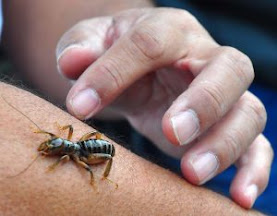Jerusalem Crickets are in no way a threat to people, they’re non-venomous and usually docile. Those big, scary-looking mandibles protruding in front of them are for chewing through dirt and roots, not for biting people. However, if they feel threatened they can emit a foul smell and are capable of doling out a nice little bite. Such a bite is usually a response to being carelessly or overly handled. They are much more likely to play dead than bite when caught.If you are still not too sure about these guys, consider the fact that they’re beneficial insects. They are omnivorous and feed on decaying organic matter in the soil, other insects and some tubers and roots. Since they are slow moving and cannot fly, Jerusalem Crickets are not out there aggressively hunting other insects as a predator would, they are instead scavenging dead or injured insects that they come across as they hop-walk around. This keeps the area they’re in above the surface tidy. And as they munch and move around underground, it keeps the soil healthy and aerated. All in all, they are beneficial to the environment and should be viewed as helpers, not as something to be stomped out – no matter how frightening they look. This creature wins my award for the insect with most names. Just some of the names are Potato Bug, Child of the Earth (Niño de la Tierra”), Devil’s Baby, Earth Baby, Qalatötö (“Shiny Bug” in Hopi), Ćićin lici (“Red Skull” in Navajo), Skull Insect, Sand Cricket and Stone Cricket. A great many people seem to think their heads look like human babies or old men and some of the names have evolved from that, but I personally can’t see that and think it’s a little creepy. Additionally, how it came to be commonly known as the Jerusalem Cricket has spawned as many theories as there are names for this insect. This article gives one short version.
Jerusalem Crickets don’t make the familiar chirping sound that we all know; but they do make noise with their hind legs. When disturbed they will rub them together and emit a sound that is more of a hiss than a chirp. A far more impressive noise that they create is the drumming sounds they use as mating calls. These sounds are quite loud and are the result of them drumming their abdomens against the ground. This drumming can not only audibly draw in a mate, can also be felt as vibrations in the ground. Unlike many other creatures, where the male tries to impress the female, both genders of Jerusalem Crickets send out these signals. As they each zero in on the other’s signal, the male and female begin a duet that allows them to find each other in their usually solitary and dark world. Each species of Jerusalem Cricket has a distinct drum sound that it uses, which assures that they find the proper mate. Jerusalem Cricket species are hard to distinguish by simple visual assessments, so scientists have been using these unique drumming sounds to differentiate between species and identify new ones. With this technique, the number of species identified has been growing steadily. Check out this video to see and hear their drumming.
If you run across one of these interesting insects, be gentle with it and send it on its way peacefully.
Take Care.
Submitted by Pam










No comments:
Post a Comment